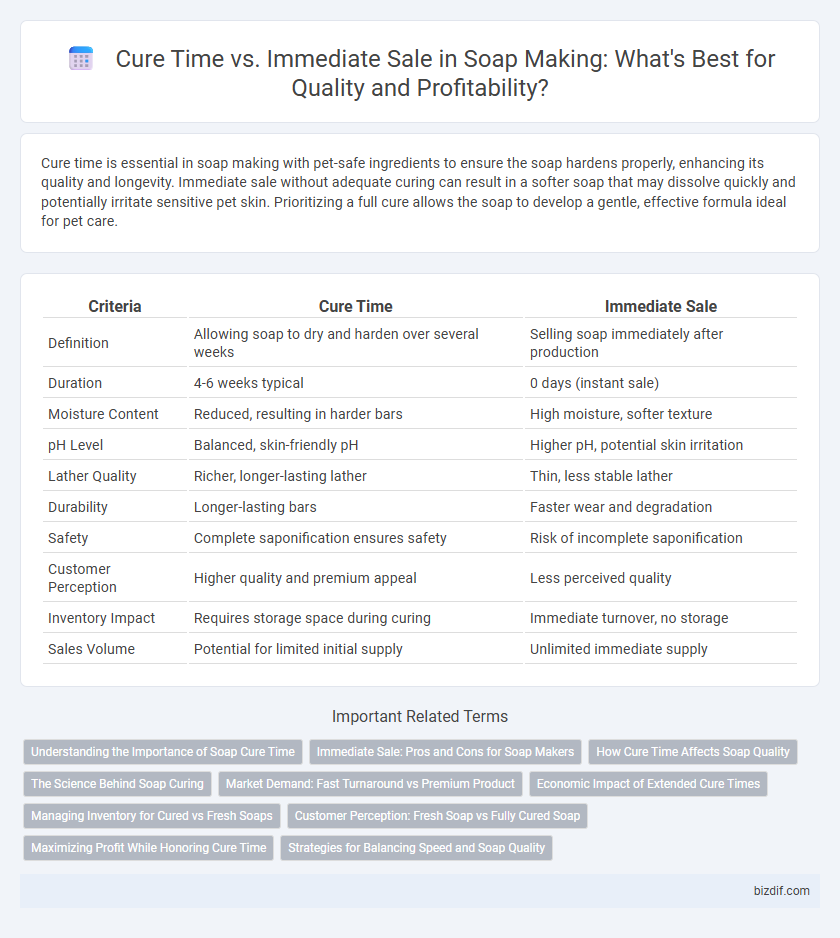Cure time is essential in soap making with pet-safe ingredients to ensure the soap hardens properly, enhancing its quality and longevity. Immediate sale without adequate curing can result in a softer soap that may dissolve quickly and potentially irritate sensitive pet skin. Prioritizing a full cure allows the soap to develop a gentle, effective formula ideal for pet care.
Table of Comparison
| Criteria | Cure Time | Immediate Sale |
|---|---|---|
| Definition | Allowing soap to dry and harden over several weeks | Selling soap immediately after production |
| Duration | 4-6 weeks typical | 0 days (instant sale) |
| Moisture Content | Reduced, resulting in harder bars | High moisture, softer texture |
| pH Level | Balanced, skin-friendly pH | Higher pH, potential skin irritation |
| Lather Quality | Richer, longer-lasting lather | Thin, less stable lather |
| Durability | Longer-lasting bars | Faster wear and degradation |
| Safety | Complete saponification ensures safety | Risk of incomplete saponification |
| Customer Perception | Higher quality and premium appeal | Less perceived quality |
| Inventory Impact | Requires storage space during curing | Immediate turnover, no storage |
| Sales Volume | Potential for limited initial supply | Unlimited immediate supply |
Understanding the Importance of Soap Cure Time
Soap cure time significantly impacts the quality and safety of the final product, as it allows excess water to evaporate and the saponification process to complete fully. Immediate sale of soap without proper curing can result in a softer, less effective bar prone to quicker degradation and potential skin irritation. Ensuring an adequate cure time of 4 to 6 weeks enhances hardness, lather quality, and longevity, optimizing customer satisfaction and product performance.
Immediate Sale: Pros and Cons for Soap Makers
Immediate sale of soap offers quicker cash flow and reduces inventory storage costs, making it appealing for small-scale soap makers. However, skipping the recommended cure time can result in softer bars with excess moisture, affecting lather quality and shelf life. This trade-off between speed and product durability requires soap makers to balance market demands with customer satisfaction and product safety.
How Cure Time Affects Soap Quality
Longer cure time significantly enhances soap quality by allowing excess water to evaporate, resulting in a harder, longer-lasting bar that produces richer lather and a more balanced pH. Immediate sale of soap after production often leads to a softer texture and a harsher feel on the skin due to incomplete saponification and residual alkalinity. Proper curing, typically 4 to 6 weeks, ensures the soap is safe, mild, and has optimal cleansing properties.
The Science Behind Soap Curing
Soap curing involves a critical chemical process called saponification, where oils and lye react to form soap and glycerin, requiring time for completion to ensure safety and quality. During the cure time, excess water evaporates, allowing the soap to harden and develop a longer-lasting, gentler lather. Immediate sale of fresh soap bypasses this essential period, often resulting in a softer, harsher product prone to rapid deterioration and skin irritation.
Market Demand: Fast Turnaround vs Premium Product
Cure time in soap making directly impacts market demand by determining whether the product targets fast turnaround or premium quality. Soaps with a shorter or no cure time allow quick inventory replenishment, appealing to customers seeking immediate purchase options. Longer cure times enhance product quality, attracting buyers willing to invest in premium, artisanal soaps that emphasize natural ingredients and skin benefits.
Economic Impact of Extended Cure Times
Extended cure times in soap making significantly influence economic outcomes by delaying product availability and increasing inventory holding costs. Longer cure periods enhance soap quality and longevity, leading to higher consumer satisfaction and potential premium pricing. Balancing cure time against immediate sale demands is critical for maximizing profit margins and maintaining cash flow stability in artisanal and commercial soap production.
Managing Inventory for Cured vs Fresh Soaps
Cure time in soap making typically ranges from 4 to 6 weeks, during which moisture evaporates and the soap hardens, enhancing quality and longevity. Managing inventory requires balancing cured soaps ready for sale with fresh batches in the curing process to ensure continuous product availability without compromising quality. Tracking batch dates and storage conditions optimizes turnover, preventing stock shortages or excess inventory of unready soaps.
Customer Perception: Fresh Soap vs Fully Cured Soap
Customers often perceive fresh soap as more fragrant and visually appealing, but fully cured soap offers superior hardness, gentler cleansing, and longer-lasting use. Immediate sale of fresh soap might attract those seeking vibrant scents and softer textures, yet a properly cured soap ensures a stable pH level and reduced risk of skin irritation. Clear communication about the benefits of curing time enhances customer trust and satisfaction, balancing initial appeal with long-term performance.
Maximizing Profit While Honoring Cure Time
Maximizing profit in soap making requires balancing cure time with immediate sale demands, as properly cured soap enhances lather quality and skin benefits that justify higher pricing. Curing typically spans 4 to 6 weeks, allowing excess water to evaporate and pH levels to stabilize, which reduces customer complaints and returns. Selling soaps prematurely may increase short-term cash flow but risks long-term brand reputation and reduces overall profit margins due to quality issues.
Strategies for Balancing Speed and Soap Quality
Optimizing cure time in soap making demands balancing thorough saponification with market readiness to ensure quality and safety. Employing accelerated curing methods like controlled temperature and humidity can reduce wait times without compromising hardness or lather. Prioritizing batch testing and clear labeling strategies enables confident immediate sales while maintaining consumer trust and product integrity.
Cure Time vs Immediate Sale Infographic

 bizdif.com
bizdif.com